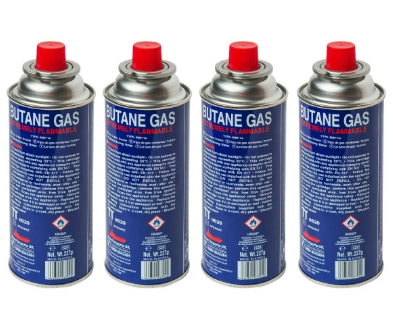
Camping is an exciting way to explore nature, but cooking outdoors can be challenging without the right equipment. Gas canister camping is a popular choice because it offers convenience, portability, and efficiency. Whether you're a beginner or an experienced camper, knowing how to use gas canisters safely and effectively is essential.
In this guide, we'll cover the best tips for using gas canisters during camping, from choosing the right one to maximizing fuel efficiency. Stay prepared and make your outdoor cooking experience stress-free!
Choose the Right Gas Canister for Your Camping Trip
Not all gas canisters are the same. Picking the right one depends on your needs and camping conditions.
Propane vs. Butane vs. Isobutane:
Propane works well in extreme cold but requires a heavier container. Butane is lightweight but struggles in freezing temperatures. Isobutane is a mix of both and performs well in various conditions.
Canister Sizes:
Small (100g) – Suitable for solo or short trips. Medium (230g) – Ideal for weekend getaways. Large (450g+) – Best for group camping or extended stays.
A medium-sized canister typically lasts 2-3 days for one person under normal use.
Always Check for Leaks Before Use
Before connecting your stove, inspect the gas canister for leaks. A leaking canister can cause serious accidents.
How to check for leaks?
- Apply soapy water to the valve and connection points. If you see bubbles forming, there’s a leak.
- Listen for a hissing sound when attaching the canister.
- If you smell gas, disconnect immediately and avoid using the canister.
Store Gas Canisters Properly
Proper storage extends the lifespan of your fuel and prevents accidents.
Storage Tips:
✔ Keep canisters in a cool, dry place away from direct sunlight.
✔ Store upright to prevent leaks.
✔ Avoid placing them near open flames or heat sources.
✔ Transport in a ventilated space, not inside a closed car in hot weather.
Use a Windshield to Save Fuel
Wind can waste a lot of fuel while cooking outdoors. Using a windshield around your stove improves efficiency by up to 50%.
✔ Set up camp in a sheltered area.
✔ Use natural windbreaks like rocks or trees.
✔ Invest in a lightweight, foldable windshield for better performance.
Know How Long a Gas Canister Will Last
Knowing how much fuel you need prevents running out unexpectedly. A standard 230g canister burns for 1 to 2 hours on medium heat.
Fuel Consumption Estimation:
- Boiling 1 liter of water takes 5-7 minutes and uses about 7-10g of fuel.
- Cooking a full meal may require 15-20g of fuel per person.
- Plan based on meal frequency and cooking time.
Use the Right Stove for Your Canister
Different stoves work with different canisters. Make sure they match before your trip.
✔ Threaded (Screw-on) Canisters: Common in backpacking stoves.
✔ Pierceable Canisters: Less convenient since they cannot be resealed after use.
✔ Lindal Valve Canisters: Compatible with high-performance stoves.
If you're unsure, check your stove’s manual before buying a gas canister camping setup.
Cook Smart to Conserve Fuel
Wasting fuel means carrying extra weight or running out early. Here’s how to cook efficiently:
✔ Preheat food at home – Reduce cooking time by prepping ingredients.
✔ Use a lid – Covering pots and pans saves fuel.
✔ Simmer instead of boiling – Lower heat settings extend fuel life.
✔ Choose quick-cooking meals – Instant rice, pasta, and dehydrated foods use less fuel.
Dispose of Empty Canisters Safely
Proper disposal of used canisters is important for the environment.
How to Dispose of Gas Canisters?
✔ Use all remaining gas by burning it off completely.
✔ Puncture empty canisters using a special tool to release any trapped gas.
✔ Recycle at designated facilities (check local regulations).
✔ Never throw a partially full canister into a fire—it can explode!
Follow Safety Precautions While Cooking
Outdoor cooking can be fun, but safety should always come first.
Important Safety Rules:
✔ Keep the stove on a stable, flat surface.
✔ Never cook inside a tent—gas fumes can cause carbon monoxide poisoning.
✔ Keep a safe distance from flammable objects.
✔ Have a backup fire starter in case the igniter fails.
A single gas-related accident can ruin an entire trip, so always stay cautious.
Pack a Backup Canister for Emergencies
Running out of fuel in the middle of nowhere is frustrating. Always pack an extra canister, especially for longer trips.
✔ For solo campers: One backup is usually enough.
✔ For group camping: Carry at least one extra per stove.
✔ Check fuel levels before each trip to avoid surprises.
Final Thoughts
Using gas-canister camping setups makes outdoor cooking convenient, but proper handling is essential. Choosing the right canister, following safety precautions, and conserving fuel can make your trip more enjoyable.
By planning ahead and using these expert tips, you can cook safely and efficiently on your next adventure. Enjoy your camping trip and happy cooking! 🚀🏕️


































